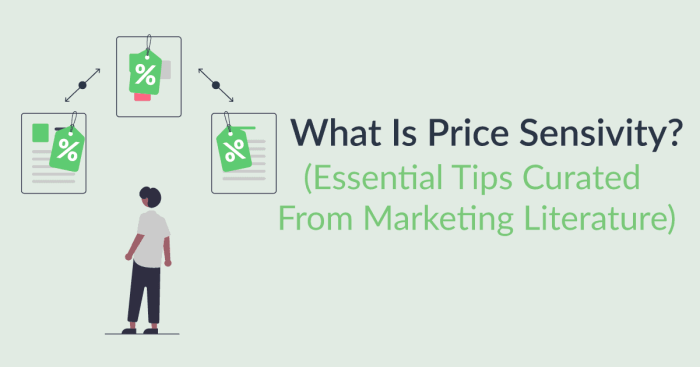
Price sensitivity research is a fascinating area that dives deep into how consumers react to changes in pricing. Understanding this concept can greatly enhance how businesses navigate their pricing strategies and engage with their target audience. As we explore this topic, we’ll uncover the various factors that influence price sensitivity and how different demographics shape consumer behavior.
This research not only reveals the significance of pricing in consumer decision-making but also offers valuable insights into market dynamics. By examining methods of conducting price sensitivity studies and their integration into broader marketing strategies, we can see how businesses can effectively leverage this information to optimize their offerings.
Understanding Price Sensitivity
Price sensitivity refers to the degree to which consumers alter their purchasing behavior in response to changes in price. It plays a crucial role in influencing consumer decisions, marketing strategies, and overall sales performance. Understanding price sensitivity helps businesses set optimal pricing strategies and tailor their offerings to the preferences of different market segments, ultimately driving sales and customer loyalty.Various factors can influence price sensitivity, which may differ across markets.
For example, the nature of the product, market competition, and the availability of substitutes can significantly affect how consumers respond to price changes. In highly competitive markets where alternatives are readily available, consumers are often more price sensitive. Conversely, in markets with fewer options or for luxury items, consumers may demonstrate lower sensitivity to price fluctuations.
Factors Influencing Price Sensitivity
Several key factors impact consumers’ price sensitivity in different contexts. Understanding these factors enables businesses to design better pricing strategies that align with consumer expectations.
- Product Type: Necessities typically see higher price sensitivity as consumers will seek the best price for essential items. In contrast, luxury goods often exhibit lower sensitivity as they are not essential for survival and buyers are willing to pay a premium.
- Market Conditions: In a saturated market, increased competition leads to higher price sensitivity, as consumers can easily switch brands if prices rise.
- Consumer Income: Higher-income consumers may show less price sensitivity, particularly for luxury items, while lower-income consumers are more affected by price increases on basic goods.
- Brand Loyalty: Established brands with loyal customer bases may experience lower price sensitivity, as consumers are willing to pay more for brands they trust.
- Availability of Alternatives: The more substitutes available for a product, the more price sensitive consumers tend to be, as they can easily switch to a competitor if prices rise.
Demographic Variables Affecting Price Sensitivity
Demographic factors such as age, gender, education, and geographic location can significantly shape price sensitivity among consumers. Understanding these variables provides valuable insights for targeted marketing strategies.
- Age: Younger consumers often exhibit higher price sensitivity, as they may have less disposable income and are more inclined to seek value. Older consumers might prioritize quality or brand reputation over price, leading to varied sensitivity levels.
- Gender: Research indicates that women may be more price sensitive than men when it comes to everyday purchases, while men might exhibit less sensitivity in categories like electronics.
- Education: Higher education levels can correlate with lower price sensitivity, as educated consumers may focus on the value and benefits of products rather than solely on price.
- Geographic Location: Consumers in urban areas may display different price sensitivity compared to those in rural regions, affected by factors such as access to product variety and income levels.
Methods of Conducting Price Sensitivity Research

To effectively understand consumer behavior regarding pricing, various methodologies for conducting price sensitivity research are utilized. These methods help businesses gauge how price changes affect consumer purchasing decisions and overall demand. By leveraging the right techniques, organizations can gather valuable insights that influence pricing strategies and improve profitability.Different methodologies can be applied to collect data on consumer price perception. These techniques include qualitative and quantitative approaches, each offering unique advantages.
A well-rounded research strategy often incorporates multiple methods to ensure comprehensive insights.
Methodologies for Conducting Price Sensitivity Studies
There are several methodologies to consider when conducting price sensitivity research. Each has its own strengths and is suitable for different contexts:
1. Surveys
This method involves distributing questionnaires to a broad audience. Surveys can be conducted through various channels, such as online platforms, telephone interviews, or mailed questionnaires. They allow researchers to gather quantitative data on consumer preferences and price elasticity.
2. In-Depth Interviews
Conducting one-on-one interviews provides qualitative insights into consumer attitudes towards pricing. This method allows for deeper exploration of consumer motivations and perceptions, revealing the nuances of price sensitivity.
3. Focus Groups
Small groups of consumers discuss their perceptions of price and value in a guided format. This method allows for interactive dialogue and the exploration of collective attitudes, providing qualitative insights that surveys may not capture.
4. Field Experiments
This involves testing different pricing strategies in real-world settings. By observing consumer behavior in response to varying prices, businesses can gauge actual price sensitivity and adjust strategies accordingly.
5. Conjoint Analysis
This statistical technique helps understand how consumers value different attributes of a product, including price. By presenting consumers with various product configurations, researchers can determine the optimal pricing strategy.
Techniques for Collecting Data on Consumer Price Perception
To effectively gather data on consumer price perception, researchers can employ several techniques. These techniques can enhance the validity and reliability of the findings:
Price Experimentation
Testing different prices for the same product in similar contexts can reveal how sensitive consumers are to price changes. It allows researchers to observe real-time reactions.
Market Analysis
Evaluating competitor prices and market trends helps contextualize consumer expectations. Businesses can understand pricing dynamics within their industry, supporting better decision-making.
A/B Testing
This method involves showing different prices to different segments of consumers simultaneously to compare responses. It offers insights into how price variations impact purchasing decisions.
Customer Feedback Platforms
Using online platforms for direct consumer feedback allows brands to gauge responses to pricing strategies and gather insights from a larger audience.
Comparative Analysis of Online Surveys vs. In-Person Focus Groups
When deciding between online surveys and in-person focus groups for price sensitivity research, it’s essential to consider the strengths and weaknesses of each method.Online surveys offer broad reach and can gather data quickly from a diverse audience. They are cost-effective and allow for statistical analysis of large sample sizes. However, they may lack the depth of understanding and emotional context that can be captured in in-person focus groups.In-person focus groups, on the other hand, facilitate rich discussions and provide qualitative insights that can uncover hidden motivations behind consumer price perceptions.
They foster interactive engagement but can be resource-intensive and may not represent the broader population effectively.| Feature | Online Surveys | In-Person Focus Groups ||———————-|——————————–|——————————|| Reach | Broad and diverse audience | Limited to specific participants || Cost | Generally lower | More resource-intensive || Data Type | Quantitative | Qualitative || Speed | Quick data collection | Time-consuming || Depth of Insight | Limited contextual understanding| Rich discussions and insights |Understanding the strengths of both methods can help businesses choose the most appropriate approach based on their specific research goals and resources.
Integrating Price Sensitivity in Market Research

Understanding how price sensitivity impacts consumer behavior is crucial for businesses aiming to optimize their pricing strategies. By integrating price sensitivity data into market research, organizations can make informed decisions that align their pricing with customer expectations, ultimately driving sales and enhancing profitability.Integrating price sensitivity findings into broader marketing strategies allows businesses to anticipate customer reactions to price changes and tailor their offerings accordingly.
By effectively utilizing this information, companies can create competitive advantages and foster customer loyalty.
Informing Product Pricing Strategies
Price sensitivity data provides insights that can directly inform product pricing strategies. Businesses can leverage this data to determine optimal pricing points that maximize revenue while remaining attractive to consumers. Key strategies for utilizing price sensitivity data include:
- Dynamic Pricing Models: Utilizing algorithms that adjust prices based on real-time market conditions and customer demand can enhance profitability.
- Market Segmentation: Understanding different segments’ price sensitivity enables tailored pricing strategies that cater to specific consumer groups.
- Value-Based Pricing: Establishing prices based on perceived value rather than costs can lead to higher customer satisfaction and increased sales.
Framework for Integrating Findings into Marketing Strategies
A comprehensive framework for integrating price sensitivity findings requires collaboration across departments. This ensures that pricing decisions resonate throughout various aspects of marketing and sales strategies. Essential components of this framework include:
- Cross-Department Collaboration: Ensuring that marketing, sales, and product development teams share insights can help in creating a unified approach to pricing.
- Consumer Feedback Mechanisms: Regularly collecting and analyzing consumer feedback regarding pricing can provide valuable insights for ongoing adjustments.
- Competitor Analysis: Monitoring competitor pricing strategies alongside consumer sensitivity can help refine a company’s pricing approach and maintain competitiveness.
Role of Marketing Software in Analyzing Price Sensitivity Metrics
Marketing software plays a pivotal role in analyzing and interpreting price sensitivity metrics. By utilizing advanced analytics tools, businesses can gain deeper insights into pricing trends and consumer behavior.Important functionalities of marketing software include:
- Data Visualization: Graphical representations of price sensitivity metrics can help teams quickly identify trends and make informed decisions.
- Predictive Analytics: Tools that analyze past consumer behavior can forecast future pricing reactions, allowing for proactive strategy adjustments.
- A/B Testing: Experimenting with different pricing strategies across segments provides real-time data on price sensitivity and helps refine approaches.
Integrating price sensitivity into market research is essential for creating strategies that are responsive to consumer demand and optimized for profitability.
Connecting Price Sensitivity with Public Relations
Understanding price sensitivity is crucial for shaping effective public relations strategies. When organizations grasp how their target audience reacts to pricing changes, they can better craft messages that resonate, ultimately enhancing brand perception and loyalty. Price sensitivity insights can provide a roadmap for PR campaigns that align with consumer expectations and market dynamics, ensuring that messaging is not only persuasive but also strategically sound.
Leveraging Price Sensitivity Insights in PR Campaigns
Incorporating price sensitivity insights into public relations campaigns allows brands to tailor their communications effectively. It is essential to connect the price points consumers are willing to accept with the messaging used in PR efforts. Utilizing data-driven insights enables organizations to create compelling narratives that address consumer concerns directly, thereby enhancing engagement.
For example, during economic downturns, brands can emphasize their value offerings while reassuring consumers about quality. Companies like McDonald’s have successfully implemented this by promoting their value menu during times of economic uncertainty, which aligns with consumers’ increased price sensitivity. Additionally, brands may choose to highlight competitive pricing strategies in their messaging, reinforcing their market position and appeal to budget-conscious consumers.
The relationship between consumer price sensitivity and brand reputation management cannot be overstated. Price sensitivity directly impacts how consumers perceive a brand’s value proposition. Brands that are able to navigate price changes while maintaining transparent communication tend to foster positive relationships with their audience. For instance, when companies like Netflix adjusted their subscription prices, they communicated the added value and benefits to mitigate potential backlash.
This strategy not only managed initial consumer resistance but also preserved the brand’s reputation in a competitive landscape.
Successful PR Strategies Incorporating Price Sensitivity Analysis
Several successful public relations strategies have effectively utilized price sensitivity analysis to enhance brand visibility and consumer trust. These strategies demonstrate the importance of aligning pricing messages with customer expectations.
Brand Communication
Effective PR campaigns communicate pricing changes transparently, emphasizing the quality and value associated with the product rather than simply the cost. For instance, when Apple launched its iPhone SE at a lower price point, the communications focused on maintaining high standards of design and technology, which appealed to price-sensitive consumers who prioritize value.
Promotional Campaigns
Companies often create limited-time offers or discounts that are strategically timed based on price sensitivity research. For example, during holiday sales, retailers like Amazon leverage insights to launch aggressive price cuts on popular items, driving sales and enhancing customer goodwill through perceived savings.
Consumer Engagement
Engaging with consumers through social media and feedback channels about their perceptions of pricing can significantly inform PR strategies. For example, when grocery chains like Trader Joe’s receive feedback about price sensitivity, they often showcase how they manage costs and pass savings along to customers, reinforcing loyalty and trust.
Crisis Management
Brands that respond effectively to price-related crises, such as backlash over price hikes, can recover quickly by demonstrating accountability and reframing their value propositions. For example, after raising prices, brands like Coca-Cola often initiate campaigns that highlight community support initiatives, thereby redirecting consumer focus toward their corporate social responsibility efforts.
Effective public relations strategies that integrate price sensitivity insights can significantly enhance brand reputation, responsiveness, and consumer loyalty.
Telemarketing and Price Sensitivity
Telemarketing is a powerful tool for reaching potential customers, but its success hinges on understanding the nuances of price sensitivity. When businesses align their telemarketing strategies with insights gained from price sensitivity research, they can significantly enhance their ability to connect with customers, boost conversion rates, and ultimately drive sales. This section delves into how telemarketing strategies can be tailored to fit the needs of price-sensitive customers and Artikels best practices for identifying these customers during calls.
Adapting Telemarketing Strategies
To effectively adapt telemarketing strategies based on price sensitivity research, organizations must first understand their target audience’s price perception. This understanding allows telemarketers to adjust their approach, emphasizing value while being mindful of price concerns. Here are key strategies to consider:
- Segmenting Customers: Classifying customers based on their price sensitivity can help telemarketers personalize their pitch. For instance, high-price sensitivity customers might be offered discounts or promotions, while less price-sensitive customers can be engaged with premium features.
- Highlighting Value: When pitching products or services, it is crucial to communicate the value proposition clearly. For price-sensitive customers, focusing on benefits and cost savings can help justify the pricing structure.
- Offering Flexible Pricing: Providing options such as payment plans or tiered pricing can cater to various levels of price sensitivity, allowing customers to choose a plan that best fits their budget.
Identifying Price-Sensitive Customers
Recognizing price-sensitive customers during telemarketing calls is essential for tailoring the conversation. Here are best practices for telemarketers to effectively uncover this information:
- Asking Open-Ended Questions: Engaging customers with open-ended questions can reveal their attitudes towards price. Questions like “What do you look for when considering a purchase?” can provide insights into their price sensitivity.
- Listening Actively: Telemarketers should pay close attention to the language and tone used by customers. Phrases like “Is this on sale?” or “What’s the lowest price?” often indicate a heightened concern about cost.
- Using Trial Offers: Offering a trial period or a money-back guarantee can attract price-sensitive customers by reducing the perceived risk associated with the purchase.
Impact on Telemarketing Script Development
Price sensitivity significantly influences the development of telemarketing scripts. Scripts must be crafted to resonate with the audience’s price concerns while effectively communicating the product’s value. Key considerations include:
- Incorporating Price Anchors: Using price anchors in scripts can help manage customer expectations. For example, stating the original price before introducing a discount can make the offer more appealing.
- Customizing Responses: Scripts should include tailored responses for different customer segments. Responses for price-sensitive customers should emphasize discounts and savings, while others may focus on quality and unique features.
- Building Rapport: Scripts should encourage natural conversation, allowing telemarketers to build rapport. A friendly, understanding approach can make price-sensitive customers feel valued and less apprehensive about discussing pricing.
“Successful telemarketing is not just about selling; it’s about understanding your customer’s needs and addressing their concerns related to price.”
Concluding Remarks
In conclusion, price sensitivity research is crucial for businesses aiming to thrive in competitive markets. By understanding consumer behavior and the factors that influence price perception, companies can tailor their marketing efforts and pricing strategies to better meet the needs of their customers. The insights gained from this research not only support effective pricing decisions but also contribute to building a strong brand reputation in the ever-evolving marketplace.
FAQ Explained
What is price sensitivity?
Price sensitivity refers to the degree to which the price of a product influences consumers’ purchasing decisions.
How does demographic data affect price sensitivity?
Demographic factors like age, income, and education level can significantly influence how sensitive consumers are to price changes.
What are common methods to measure price sensitivity?
Common methods include surveys, focus groups, and experiments that assess consumer reactions to different price points.
Why is price sensitivity important for businesses?
Understanding price sensitivity helps businesses set competitive prices, forecast demand, and enhance their marketing strategies.
How can price sensitivity impact brand reputation?
Price sensitivity can affect consumer perceptions of value and quality, influencing brand loyalty and reputation management.






